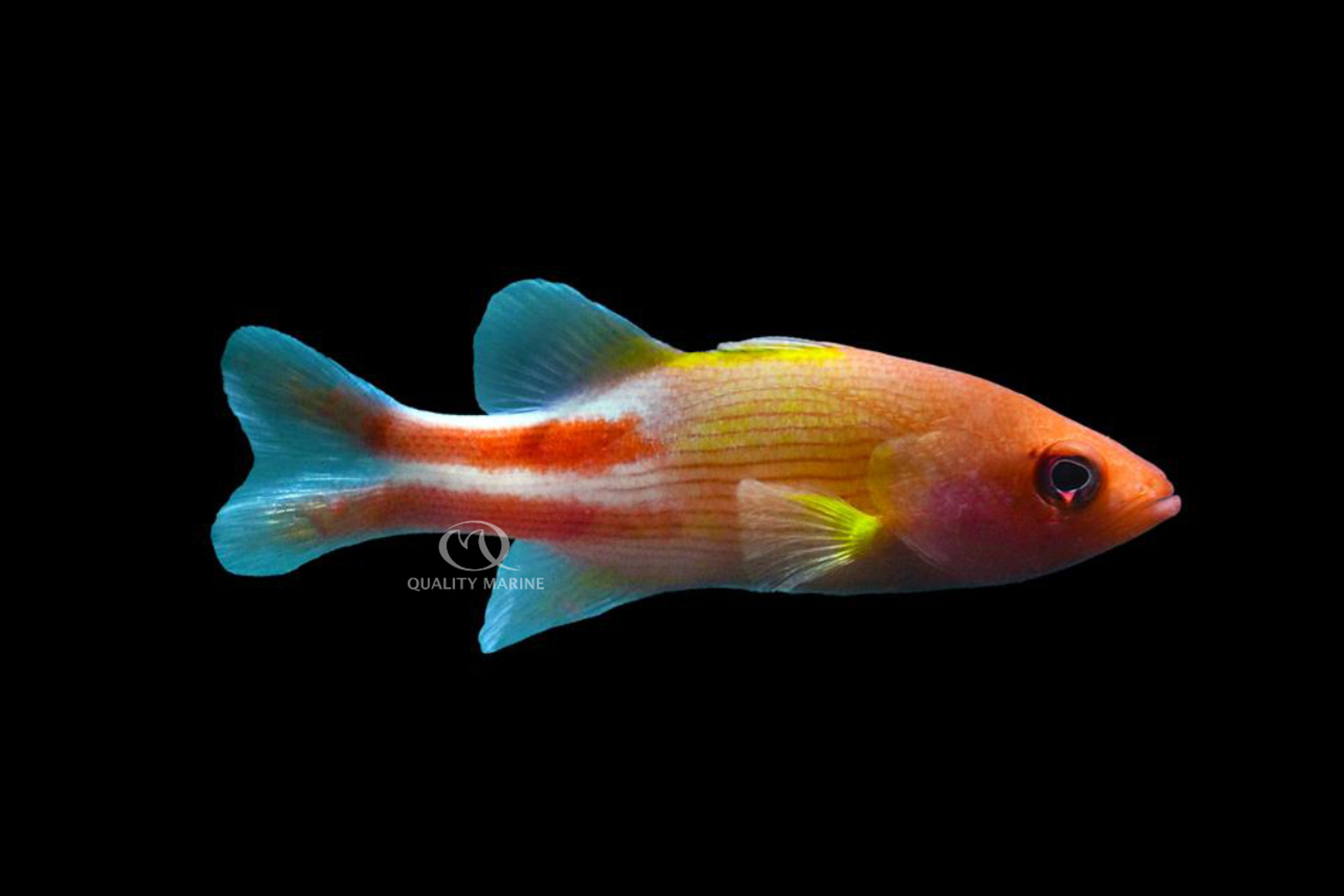Whose Multiline Is It Anyway?

Outside of the aquarium world, Liopropoma multilineatum is known as the “many-lined” or “muliti-lined” Perch or Basslet. Inside the aquarium world, it is most often called the Multilineatum Basslet. Less frequently, it gets called the Yellow (or Yellow Lined) Sea Perch. It is a member of the Serranidae family, which includes things like Seabass and Groupers. It's crazy that a family full of fish that are more easily measured in feet would include something like the Multilineatum, a brightly colored little fish that rarely gets bigger than three inches long or so! They are gorgeous fish, with an ombre fade that starts with a pink head into a yellow and pink striped body, with horizontal red and white stripes over the tail section.
Even though Multilineatum Basslets are a much more appropriate size for aquariums that the vast majority of their family, they are still a very rare site in home displays. They are regularly collected in relatively shallow water and can be found as shallow as 30 feet down and rarely getting deeper than 150 feet down. So why the rarity? They are hard to find! These secretive little guys like to live under overhangs and in tiny caves. Adding to the difficulty in finding them is a unique color camouflage; in the very shallow water of the home aquarium, the red and pinks show very prominently. However, red wavelengths of light are some of the first to be filtered by water and so in the deeper waters of their home, Multilineatum Basslets appear to be mostly shades of gray.
As a result of their diminutive size, and fairly sedate lifestyle, Liopropoma multilineatum does not require a very big aquarium. In fact, you could happily keep one to maturity in a 30-gallon display. The tank should offer copious rockwork with many overhangs and other areas of dim lighting. You can have them in aquariums with bright lighting, but they will be more prone to hiding. We suggest keeping these lights dim, especially while feeding during the first couple weeks of acclimation. Other than that, the more places they can hide, the more comfortable they will feel, and the more often you will see them in the open. They're good candidates for bare bottom displays and can handle moderate flow as long as it is random/turbulent in nature. They aren't natural jumpers, but we recommend a covered tank anyway as they can hit a pretty surprising rate of speed, and doing this in the wrong direction could still land them on the floor.
A well-established tank is a good idea, as they'll do best in a pH and nutrient stable environment. Try to keep that pH north of 8.0 but below 8.4, and the nitrates south of 5.0ppm. Temperature should be in the mid to low 70s (F) and the salinity can be anywhere from 1.020 to 1.026. If you mix Tropic Marin salt (always our recommendation) with R/O water according to their instructions, you should get water that is 1.025-1.026 every time.
Pretty much all Liopropoma Basslets are easy to feed as long as you can get food to them. The primary difficulty in getting them to start eating is them learning when the food truck pulls up! In aquariums with many other fish, the food may be gone before the Basslet realizes there was anything to eat! If this is a problem for you, just use a baster to get some food into their hideout when you feed everything else. Sooner than later, they'll learn feeding times and be out and about to get their share. Here we feed them a mix of meaty foods at least twice a day, and we mix a little Nutramar Pellet in to start them learning what pellets are. The base of the mix is usually Gamma Mysis, Gamma Enriched Brine(s), Gamma Chopped Prawn and Chopped Mussel. Once they are on to the pellets, they'll do well on that alone for at least one of the two (or more) daily feedings.
Like most other Basslets, Multilineatums are unlikely to bother your corals. Unlike most other Basslets, these are small enough not to be a menace to those corals via pure size and waste production. Long story short, they are low risk in your reef tanks. Really the only invertebrates at risk with Liopropoma multilineatum are shrimp that are small enough to become a meal, like some in the Periclimenes genus. This is a peaceful and shy critter, and so you should avoid keeping them with very aggressive fish. Good choices are other small peaceful fish, whose presence will help the little Basslet feel safer in the open; fish like Firefish, Pencil Wrasses, Cardinals, Gobies, and even some Clownfish would be all good tank mate material.
The Multilineatum Basslet is a fish not frequently seen in the aquarium trade. Its bright colors, and uniqueness are likely to make a great talking piece for any aquarist lucky enough to get one of these for their aquarium. Talk to your local fish store today about one of our sustainably sourced Multilineatum Basslets from Quality Marine today!